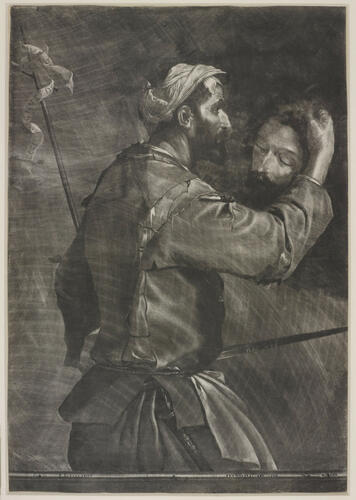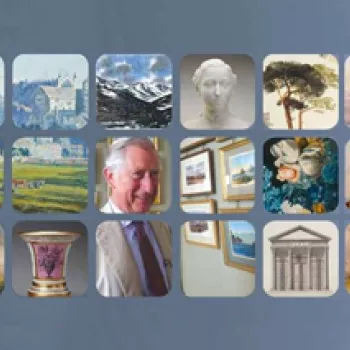The Great Executioner 1658
Mezzotint | 62.6 x 43.7 cm (whole object) | RCIN 503058
-
A mezzotint of a three-quarter length male figure, standing in profile to the right, holding the head of John the Baptist in one hand, and a sword in the other.
The first royal artist to produce a substantial body of work was Prince Rupert. Born in Prague, Rupert was the third son of King Frederick V of Bohemia and Elizabeth Stuart, the daughter of James I, and sister of Charles I. Today, Rupert is best remembered as a military leader, scientist and inventor; but he should also be considered a talented and inventive artist. Many of Prince Rupert’s formative years were spent in England at the court of his uncle, Charles I. During the English Civil War Rupert served as a cavalry commander, later becoming Captain-General of the Royalist army. Following the king’s defeat, Rupert was forced into exile in the Netherlands, and it was during this time that he encountered a German soldier and amateur artist called Ludwig von Siegen, who had invented the new art of mezzotint.
Mezzotint is a form of engraving which allows subtle half-tones to be created. In order to achieve this, the copper plate is roughened with thousands of little dots, which hold the ink when the face of the plate is wiped clean, allowing a greater tonality to result in the finished print.
Prince Rupert engraved at least seventeen separate mezzotint plates, from which a number of impressions could be taken. The most accomplished and dramatic of these is The Great Executioner, a large-scale print based on a painting of the 1640s attributed to the Spanish painter José de Ribera (called Lo Spagnoletto, hence the inscription Sp. In[venit].). Rupert’s name is signed along the executioner’s blade. The subject-matter of this print could be associated with the execution of Rupert’s uncle, Charles I, in January 1649. His reduced version of this print, bound in to John Evelyn's Sculptura of 1662, was the first mezzotint published in England. -
Creator(s)
(mezzotinter) -
Medium and techniques
Mezzotint
Measurements
62.6 x 43.7 cm (whole object)
99.5 x 77.0 cm (frame, external)
Object type(s)










